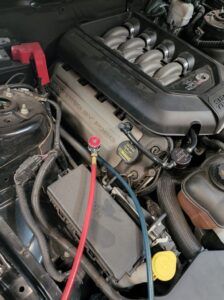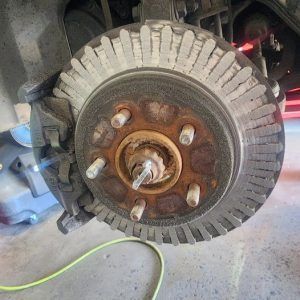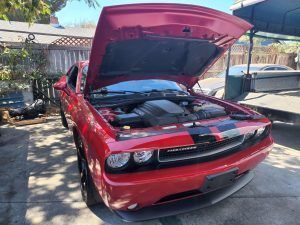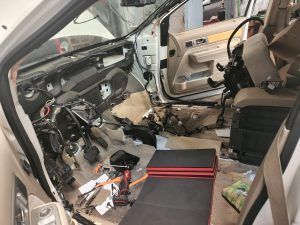Why Is My Car AC Expansion Valve Leaking and How to Fix It
(A Complete Guide for Chico, CA Drivers)
Introduction: Why Expansion Valves Matter in Chico
When summer heat hits Chico, CA, a working air conditioner isn’t just about comfort—it’s about safety. At the center of your car’s AC system is a small but powerful device called the expansion valve.
This valve regulates refrigerant flow, keeps temperatures balanced, and makes sure the air blowing through your vents is icy cold. When it begins to fail or leak, performance drops fast. Warm air, frequent refrigerant recharges, compressor strain, and even catastrophic system failure can follow.
This guide will take you through everything you need to know about expansion valves:
How they work
- Who invented them and when cars first used them
- Different expansion valve styles and their roles
- Why they leak and what symptoms to watch for
- Professional vs. DIY repair methods
- Maintenance tips to prevent future leaks
- Why Tedious Auto Repair in Chico is your best local option
- Local driving directions from Hamilton City, Paradise, and Nord Ave
👉 Ready to schedule your repair now? Book your appointment here.
The Science of Automotive AC
To understand why expansion valves leak, let’s review how your AC system works.
1.Compressor – Pressurizes refrigerant and pushes it through the system.
2.Condenser – Cools the pressurized refrigerant into a liquid.
3.Receiver/Drier – Filters contaminants and removes moisture.
4.Expansion Valve – Regulates refrigerant entering the evaporator.
5.Evaporator – Absorbs heat from cabin air, creating cold airflow.
The expansion valve’s job is to drop refrigerant pressure before it enters the evaporator. This sudden pressure drop allows the refrigerant to evaporate quickly, absorbing heat from the air inside your vehicle. Without a properly functioning expansion valve, refrigerant flow is unbalanced, cooling is inconsistent, and system pressure becomes dangerous.
A Brief History of Expansion Valves
Early Cooling Systems
The first vehicle air conditioning systems appeared in the 1930s. Packard was one of the first automakers to offer AC in 1939. These early systems were large, costly, and used primitive flow-control methods.
Introduction of the Expansion Valve
By the 1950s, thermal expansion valves (TXVs) became the standard for controlling refrigerant flow. Bosch, Bendix, and later Japanese suppliers refined the technology. By the 1970s, most American and European vehicles used TXVs as part of factory AC systems.
Modern Developments
1980s: Automakers experimented with block-style expansion valves (H-valves), compact and reliable for passenger cars.
1990s: Electronic expansion valves (EEVs) began appearing, offering precise control using electronic sensors.
2000s to Today: Hybrid and electric vehicles use expansion valves designed for energy efficiency and integration with high-voltage compressors.
Types of Expansion Valves
Expansion valves aren’t one-size-fits-all. There are several types, each with unique benefits.
1. Thermal Expansion Valve (TXV)
- Uses a sensing bulb to monitor temperature.
- Common in passenger cars and light trucks.
- Provides consistent cooling but can clog with debris.
2. Block or H-Valve
- Compact design mounted directly to the evaporator.
- Reliable and easier to package in modern vehicles.
3. Orifice Tube
- Fixed orifice instead of an adjustable valve.
- Lower cost but less efficient under varying loads.
- Common in GM vehicles in the 1980s–1990s.
4. Electronic Expansion Valve (EEV)
- Controlled by the vehicle’s PCM (engine computer).
- Adjusts refrigerant flow in real time.
- Essential for hybrids and EVs.
👉 At Tedious Auto Repair, our ASE-certified technicians are trained to repair or replace all expansion valve types, from older TXVs to modern EEVs.
Why Expansion Valves Leak
Leaks can develop for several reasons:
- Corrosion – Moisture and road salt damage the valve body.
- Debris – Particles clog internal passages, stressing seals.
- Wear and Tear – Diaphragms and seals weaken with age.
- Improper Refrigerant Charge – Over-charging or under-charging stresses the system.
- Heat Cycles – Constant heating and cooling expand and contract the metal.
Left untreated, leaks reduce cooling power, increase compressor load, and can cause total system failure.
Symptoms of a Failing Expansion Valve
Watch for these signs:
- AC blows warm or inconsistent air
- Hissing sounds near the firewall or evaporator
- Visible frost or oil residue around AC lines
- Cabin cools only while driving, not idling
- Frequent need to recharge refrigerant
If your AC isn’t cooling like it used to, the expansion valve may be the culprit.
Diagnosing and Repairing Expansion Valve Leaks
Diagnosis
Professional mechanics use:
- Manifold gauges to measure high/low system pressures.
- Refrigerant sniffers to detect leaks.
- UV dye tests for pinpoint accuracy.
Repair Steps
1. Recover refrigerant safely.
2. Remove AC components blocking access.
3. Disconnect refrigerant lines.
4. Remove the old expansion valve.
5. Clean connections and install a new OEM valve.
6. Vacuum system and recharge refrigerant.
7. Test system for pressure balance and cooling performance.
💡 At Tedious Auto Repair, we source OEM valves through trusted suppliers like Ranshu to guarantee fit and durability.
Preventive Maintenance
To extend your AC system’s life:
- Schedule annual AC inspections.
- Replace cabin and AC filters regularly.
- Run your AC briefly during winter to keep seals lubricated.
- Avoid overcharging refrigerant.
- Address small leaks early to prevent compressor damage.
👉 Get your AC system checked today.
Why Tedious Auto Repair Is Chico’s Best Choice
At Tedious Auto Repair, we’ve been serving Chico for over 17 years with trusted, high-quality automotive repair. Here’s why locals and Chico State students choose us:
Expert Technicians – ASE-certified and experienced with gas, diesel, hybrid, and EV vehicles.
All Axle & AC Repairs – We handle CV axles, solid axles, compressors, and expansion valves.
OEM & Performance Parts – Partnered with brands like Ranshu.
Transparent Pricing – Free quotes and honest estimates.
Local Reputation – 5-star reviews across Chico, Hamilton City, Paradise, and beyond.
Whether you’re a student driving across campus or a contractor hauling tools in 100-degree weather, we’ll keep your AC blowing cold.
👉 Request a quote here or text us to schedule.
Driving Directions to Tedious Auto Repair
From Hamilton City, CA
- Head east on CA-32 toward Chico.
- Drive about 11 miles (15 minutes).
- Tedious Auto Repair will be on your right at 2695 CA-32, Chico, CA 95973.
📍 Google Maps Directions
From Paradise, CA
- Take Skyway south to Chico.
- Merge onto CA-32.
- Drive 3 miles east.
- Shop is on the right.
From Nord Ave (Chico State area)
- Head south on Nord Ave.
- Merge onto West Sacramento Ave.
- Take CA-32 East.
- Arrive at Tedious Auto Repair.
Conclusion
A leaking or failing AC expansion valve isn’t just an inconvenience—it’s a warning sign that your cooling system needs professional attention. By understanding the history, function, and common problems of expansion valves, you can make informed decisions and avoid costly repairs.
With 17+ years of experience, Tedious Auto Repair in Chico, CA is your trusted local shop for AC repair, check engine diagnostics, brake service, and more.
👉 Don’t wait until your AC stops blowing cold. Book your appointment today and let us keep you cool, safe, and comfortable on Chico’s hottest days.







